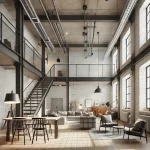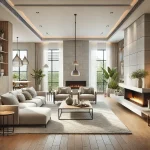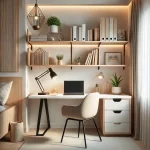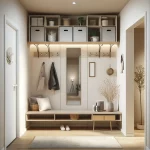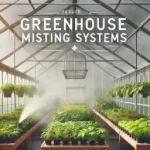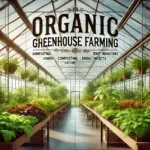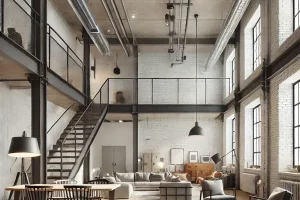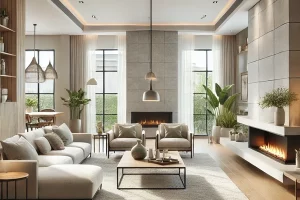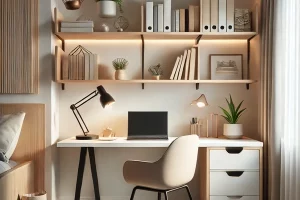A Greenhouse attached to house is a special space where you can grow plants all year. It’s like a regular greenhouse, but it’s connected to your home.
Why People Like It? More and more people are adding these greenhouses to their homes. Here’s why:
- Easy to Use: You can walk right into it from your house.
- All-Year Plants: Grow fruits, veggies, and flowers no matter the season.
- Extra Space: It can also be a sunny spot to relax in.
Having a greenhouse right next to your home is a smart way to garden. You get fresh food and a fun place to hang out all in one!
What is a Greenhouse Attached to a House Called?
Do you know what a greenhouse attached to a house is called? People often call it an “attached greenhouse.” Some also call it a “lean-to greenhouse” or a “home-attached greenhouse.” It’s like a special room for plants that is part of your house!
This cool space does many things! You can grow plants, herbs, and veggies all year. No need to worry about cold or hot weather. Your plants will be happy here!
It can also be a sunny room for you to relax in. It’s a great spot to read a book or enjoy your morning coffee. Plus, it’s a nice way to go from inside your house to your yard.
How to Build a Greenhouse Attached to Your House
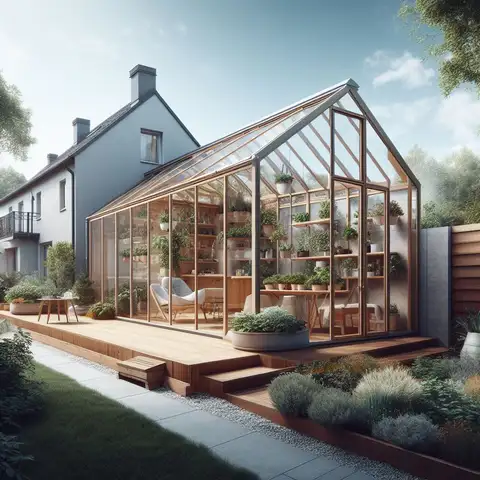
Building a greenhouse attached to your house can be a rewarding project. Here’s a simple guide to help you get started.
Materials Needed:
- Measuring tape
- Wooden or metal frames
- Polycarbonate or glass panels
- Screws and nails
- Hammer and screwdriver
- Sealant
- Ventilation system (optional)
- Heating system (optional)
Step-by-Step Guide:
- Plan and Measure: Decide where you want to attach the greenhouse and measure the area. Make sure to consider the angle of sunlight and accessibility from inside the house.
- Get Permits: Check local building codes and get any necessary permits.
- Prepare the Site: Clear the area of any debris and level the ground. You may need to lay a foundation depending on your design.
- Build the Frame: Start by constructing the frame. It could be made of wood or metal, depending on your preference and needs. Attach the frame securely to the house wall.
- Install Panels: Once the frame is up, install the polycarbonate or glass panels. Make sure they are securely fastened to withstand wind and weather.
- Seal the Edges: Use a weatherproof sealant to seal any gaps between the panels and the frame. It will help keep the greenhouse temperature stable.
- Install Door and Windows: Add a door for access and windows for ventilation. You can also install an automated ventilation system.
- Optional Heating: Depending on your climate, you may need to install a heating system.
- Test: Before you start planting, spend a few days monitoring the temperature and humidity to make sure it’s suitable for your plants.
- Plant: Once everything is set up and you’re happy with the environment, you can start planting.
Problems with Greenhouse Attached to House
Having a greenhouse attached to your house is super cool! But sometimes, problems can pop up. Don’t worry! Here are some common issues and how to fix them.
Too Hot or Too Cold
Problem: Sometimes, the greenhouse can get too hot in summer or too cold in winter.
Fix: Use shades to block some sun in the summer. In winter, use a small heater to keep it warm.
Bugs and Pests
Problem: Bugs like to visit greenhouses. They can harm your plants.
Fix: Use safe bug sprays that won’t hurt your plants. You can also use sticky traps to catch the bugs.
Water Issues
Problem: More water can be good for plants.
Fix: Make sure to water your plants just right. Use a watering can or set up a drip system.
High Costs
Problem: Building and running a greenhouse can cost a lot of money.
Fix: Plan well before you build. Use cost-effective materials and do some work yourself to save money.
Space Issues
Problem: Sometimes, the greenhouse can take up too much space.
Fix: Plan the size carefully. Make sure you have enough room for both the greenhouse and your yard.
So, if you face any of these problems, now you know how to fix them!
Modern Greenhouse Attached to House
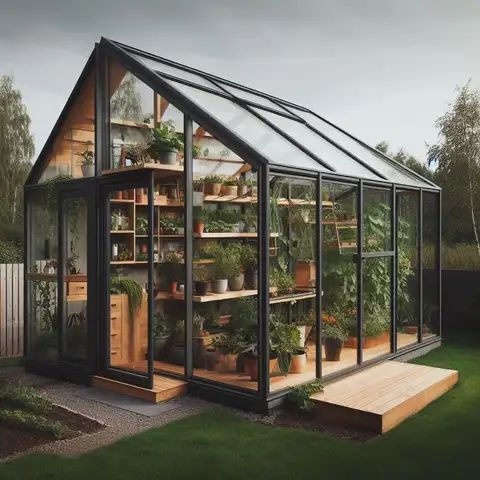
Modern greenhouses that are attached to houses are really neat! They have cool features that make them both pretty and useful. Let’s look at some of these features:
Smart Tech
Feature: Many modern greenhouses come with smart tech-like apps that tell you when to water your plants.
Sleek Design
Feature: These greenhouses often have a sleek, clean look. They use materials like glass and metal to make it look cool.
Energy Saving
Feature: Modern designs often use solar panels or other ways to save energy. It is good for the Earth and your bills!
Automatic Systems
Feature: Some have systems that water your plants or control the temperature for you. It’s like having a robot helper!
Multi-Use Space
Feature: These greenhouses can be more than just a place for plants. Some have space for you to sit and relax, almost like an extra room in your house.
Easy to Use
Feature: Modern greenhouses are made to be easy for everyone to use, even if you’re new to gardening.
DIY Greenhouse Attached to House
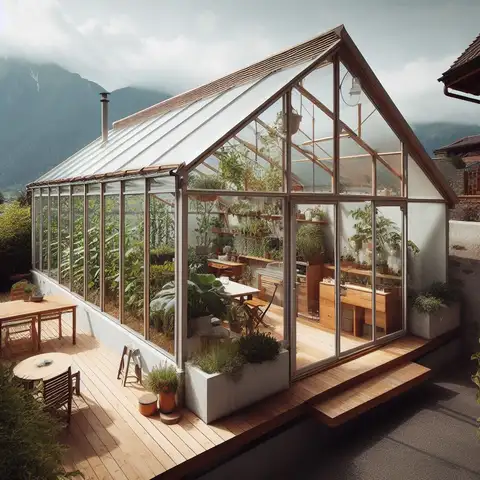
Building your greenhouse that’s attached to your house can be a fun project! Here are some tips to help you out:
Plan First
Tip: Before you start, make a plan. Know where you want to build it and how big it should be.
Get the Right Tools
Tip: Make sure you have all the tools you need. It may include hammers, nails, and a saw.
Pick Good Materials
Tip: Use strong materials that will last a long time. Wood and metal are often good choices.
Ask for Help
Tip: Building can be hard work. Be bold and ask friends or family to help you.
Safety First
Tip: Always be safe. Wear gloves and safety glasses to protect yourself.
Greenhouse Attached To House Kits
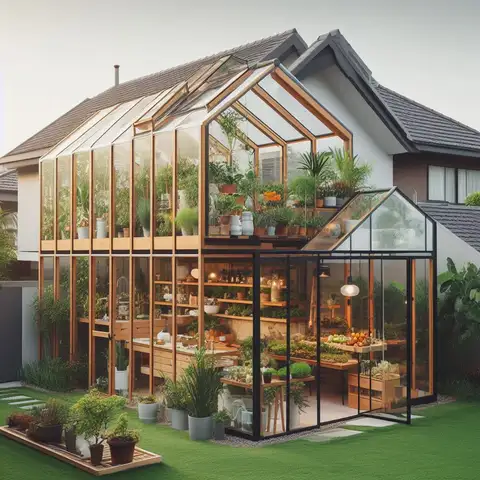
If you don’t want to start from scratch, you can buy a kit that has everything you need. Here’s what to look for:
Complete Set
Tip: Make sure the kit has all the parts you need. You don’t want to start building and then find out something needs to be added!
Good Instructions
Tip: A good kit will come with clear instructions that are easy to follow.
Quality
Tip: Check reviews to make sure the kit is of good quality. You want it to last a long time.
Size
Tip: Make sure the kit is the right size for the space you have.
Extras
Tip: Some kits come with extra stuff like shelves or hooks for hanging plants. These can be really useful!
Greenhouse Attached To House Ideas
Having a greenhouse attached to your house is not just practical; it can also be really fun and pretty! Here are some creative and useful ideas to make your attached greenhouse awesome:
Plant Wall
Idea: Turn one wall into a “plant wall” with shelves and hooks. You can grow herbs, flowers, or even small veggies!
Reading Nook
Idea: Add a comfy chair and a small table to create a cozy reading nook. Enjoy a book surrounded by your plants.
Fairy Lights
Idea: Hang up some fairy lights for a magical feel. It will look pretty and help your plants grow.
Water Feature
Idea: Add a small fountain or pond. The sound of water is relaxing, and it can help keep the air moist for your plants.
Kids’ Corner
Idea: Make a small area where kids can plant their little garden. It’s a fun way to teach them about plants.
Art and Decor
Idea: Hang up some art or put in some statues to make the space feel special. Just make sure they are okay to get a little wet from the plants.
Vertical Garden
Idea: If you need more floor space, use the walls! Vertical gardens can hold a lot of plants without taking up room.
Breakfast Bar
Idea: Add a small table and some stools to create a breakfast bar. Imagine eating your morning meal surrounded by greenery!
Pet-Friendly Plants
Idea: If you have pets, make sure to have some plants that are safe for them. That way, they can enjoy the greenhouse too!
Seasonal Themes
Idea: Change the decor with the seasons. Have some pumpkins in the fall or bright flowers in the spring.
With these ideas, your attached greenhouse can be a fun, happy place for everyone in the family!
Greenhouse Attached To House Name
When it comes to what we call a greenhouse that’s part of a house, there are a few names you might hear:
Attached Greenhouse
Term: This is a simple way to say it. The greenhouse is attached to the house.
Lean-To Greenhouse
Term: This name comes from how the greenhouse “leans” on one wall of the house.
Sunroom
Term: Some people call it a sunroom, especially if it’s a place to sit and not just for plants.
Conservatory
Term: This is a fancier name you might hear. It’s often used when the space is also used for sitting and relaxing, not just plants.
Solarium
Term: This term is often used when the room is used to catch a lot of sun, both for plants and for warmth.
Greenhouse Attached To House Cost
Building a greenhouse onto your house can cost different amounts based on a few things:
Size
Factor: Bigger greenhouses will cost more than smaller ones.
Materials
Factor: If you use expensive materials like glass or special wood, it will cost more.
Labor
Factor: If you hire people to build it, that will add to the cost.
Extras
Factor: Things like heating, cooling, or fancy lights can add to the price.
Price Range
Cost: A simple, small attached greenhouse might cost as low as $500 if you do it yourself. A big, fancy one can cost up to $20,000 or more.
Greenhouse Attached To House Pros and Cons
Having a greenhouse attached to your house can be great, but there are some things to think about, too. Here are the good and not-so-good parts:
Pros (Good Things)
More Growing Time
Advantage: You can grow plants all year, even when it’s cold outside.
Close to Home
Advantage: It’s easy to take care of your plants because the greenhouse is right next to your house.
Saves Money
Advantage: You can save on heating costs because the greenhouse can help keep your house warm.
Extra Living Space
Advantage: You can use it as a sunroom or extra room, not just for plants.
Easy to Watch
Advantage: It’s easy to keep an eye on your plants. You can see them every day.
Cons (Not-So-Good Things)
Cost
Disadvantage: Building it can be expensive, especially if you want a big one or use costly materials.
Takes Up Space
Disadvantage: It will take up space that you might want to use for something else.
Extra Work
Disadvantage: You have to take care of the plants, which takes time and work.
Heating Issues
Disadvantage: In the summer, it can get too hot, and you need to cool it down.
Bugs and Pests
Disadvantage: You might get bugs or other pests that you have to deal with.
Greenhouse Attached to House Plans
When you want to build a greenhouse attached to your house, having a good plan is key. Here are some things to think about:
Types of Plans
Designs: You can pick from many designs like lean-to, even-span, or window-mounted.
Size
How Big: Think about how much space you have and what you want to grow.
Materials
What to Use: Wood, metal, and glass are common materials. Pick what works best for you.
Permits
Legal Stuff: Check if you need any permits to build in your area.
Budget
Money: Make sure you know how much you can spend.
4 Season Greenhouse Attached to House
A 4-season greenhouse lets you grow plants all year. Here’s why it’s cool:
Grow More
Benefit: You can grow plants that need different seasons because you can control the temperature.
Energy Savings
Benefit: In winter, the greenhouse can help keep your house warm, saving you money.
More Light
Benefit: These greenhouses are designed to catch a lot of light, which is good for your plants.
Strong Build
Benefit: They are built to handle all kinds of weather, like snow and wind.
Flexibility
Benefit: You can use it for different things, not just growing plants. Some people use it as a living space, too.
Victorian Greenhouse Attached to House
Victorian greenhouses are all about style and charm. Here’s what makes them special:
Looks
Design: They often have a classic, old-world look with lots of details.
Space
Roomy: These greenhouses usually have more space, including height for tall plants.
Materials
Quality: They often use high-quality materials like wrought iron and glass.
Price
Cost: Because they are so fancy, they can be more expensive.
Glass Greenhouse Attached to House
Glass greenhouses are popular for many reasons, but they have some downsides, too.
Pros
Light: Glass lets in a lot of light, which is good for plants.
Looks: They often look cleaner and more modern.
Cons
Cost: Glass can be expensive to buy and install.
Safety: Glass can break more easily than other materials.
Conclusion
Picking the right type of greenhouse to attach to your house is a big decision. It affects how well your plants will grow and how much you’ll enjoy using them.
Whether you go for a modern design, a 4-season model, or even a Victorian-style greenhouse, make sure it fits your needs and your budget.
And remember, building your greenhouse can be a rewarding project that pays off in fresh veggies, beautiful flowers, and a nice place to relax. So why not give it a try?
FAQs About Greenhouse Attached to House
What is a Greenhouse Attached to a House Called?
It’s often called an “attached greenhouse,” but you might also hear “lean-to greenhouse” or “home-attached greenhouse.”
How Do I Build One?
You’ll need some building materials like wood or metal and clear panels for the roof and sides. It’s best to have a plan and some help.
Are There Any Problems I Should Know About?
Sometimes, these greenhouses can get too hot or too cold. You’ll need to think about temperature control.
What’s Special About Modern Designs?
Modern designs often use energy-saving materials and may include smart tech to control temperature and water.
Can I Build It Myself?
Yes, you can! There are DIY kits and lots of tips online to help you.
What Should I Look for in a Kit?
Make sure it has all the parts you need and good instructions. Quality matters, too.
Any Cool Ideas for My Greenhouse?
You could add a sitting area or a pond! Some people use them to grow herbs for cooking.
What’s the Cost Like?
Costs can vary a lot. It depends on the size, materials, and whether you build it yourself or hire someone.
Pros and Cons?
Pros include easy access to your plants and the ability to grow year-round. Cons might be the cost and the need for temperature control.
What About 4-Season Greenhouses?
These are designed to work all year, even in winter. They are well-insulated and may have heating.
Victorian Style or Glass: Which is Better?
Victorian style is more about looks, while glass types are often about performance. Both have pros and cons.
Can I Grow Food in It?
Absolutely! Many people use these spaces to grow fruits, veggies, and herbs right next to their kitchen.
